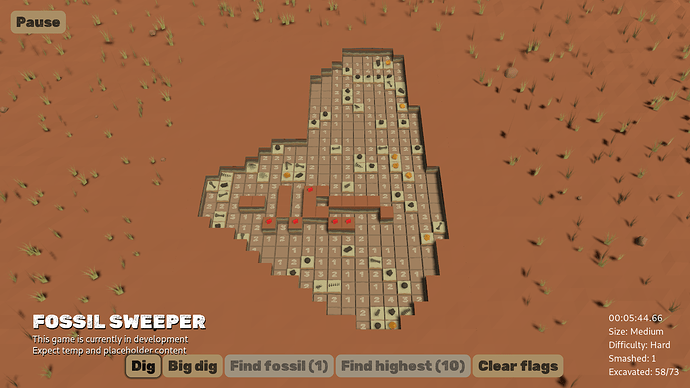Hi hi! My name’s Cheese, and I’m currently making a Minesweeper-inspired puzzle game called Fossil Sweeper, where instead of being about boring stuff like unexploded ordinances, it’s about finding the most exciting buried treasure, DINOSAURS!
I stream weekly on Twitch for “Fossil Friday” and also release monthly dev log videos. Here’s the most recent one (which is a bit bigger than usual, sumarising the 2nd year of development):
At the time of writing, I’ve been working on this larger version of the project for about 2 years, following releasing a little prototype that explored the basic premise.
My current short pitch is “Like Minesweeper, but you’re digging up fossils, and you get to build skeletons out of the stuff you find,” and structurally, the project is a Minesweeper-style game wrapped in layers of metaprogression, each with their own distinct gameplay:
- Dig phase yields fossil chunks and possible misc fossils
- Assembly phase lets you build fossil chunks into skeletons and reveals misc fossil contents
- Museum phase lets you showcase your skeletons and misc fossils
- Research phase lets you “spend” spare fossils on additional museum rooms, customisation options, abilities, etc.
All of these game loops are present in the game, and I’m currently focused on fleshing out the museum phase to a point where I feel comfortable moving from my quick-and-dirty first pass to a more-thought-out final implementation.
I’m making Fossil Sweeper with the support of a small recoupable grant from Screen Tasmania, a local State funding body mostly focused on film, but expanding into supporting game development. To help demistify the process and share what I’ve learned, I did a three part stream where I talked about my grant application, going over my pitch doc, preliminary budget, and navigating the feedback process.
Last, but not least, I’m not making Fossil Sweeper on my own - I’m working with composer Peter Silk (who collaborated with me on some of my previous Godot games, Hive Time, Bat Egg, and Supply Chain), and sound designer Jasmine Serrano (who is also working with me on In The Snowy Winter’s Wake).
I’m looking forward to sharing more with the community as I progress!






















